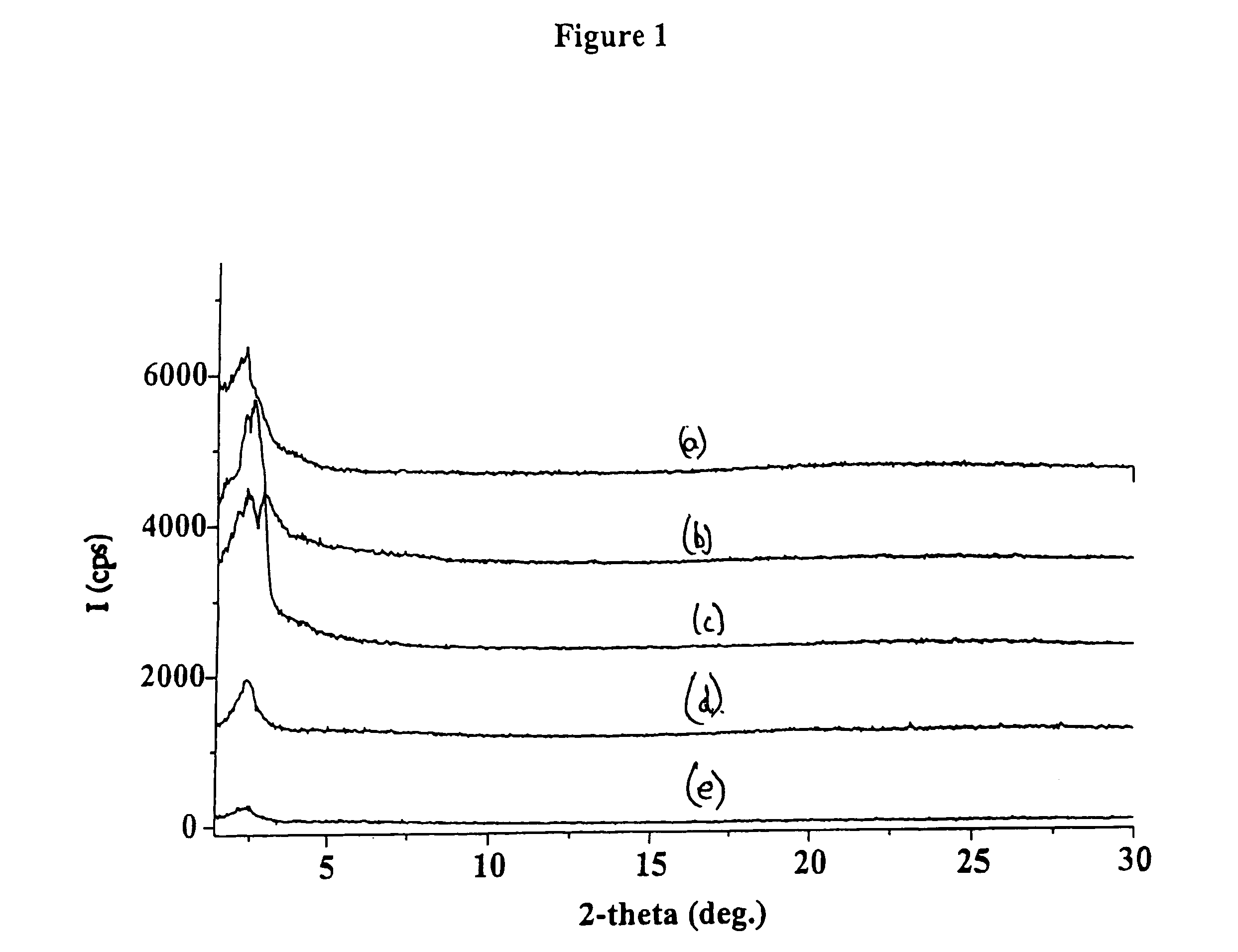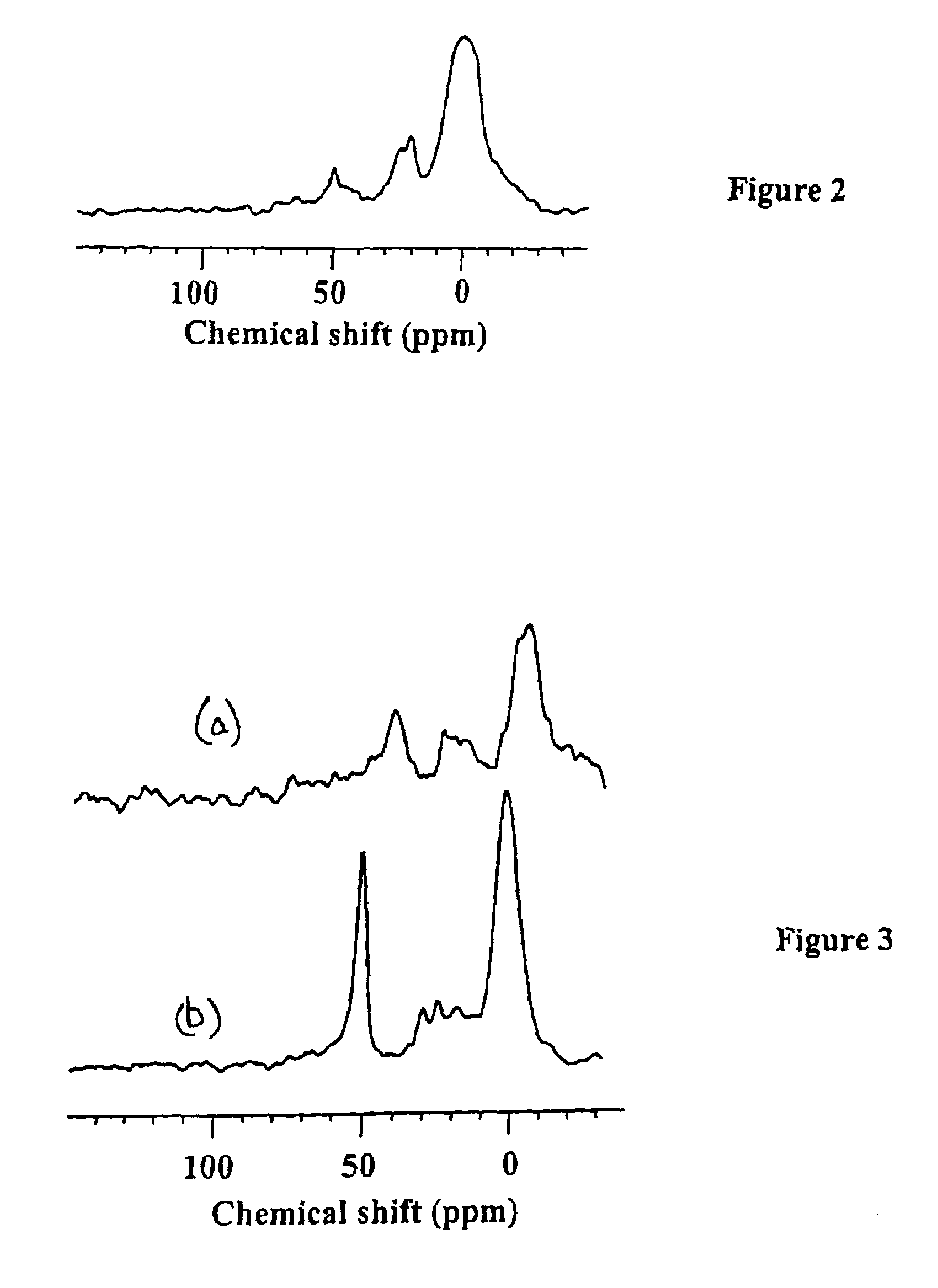Functionalized periodic mesoporous materials, their synthesis and use
a technology of periodic mesoporous materials and functionalized periodic mesoporous materials, which is applied in the direction of organic compound/hydride/coordination complex catalysts, physical/chemical process catalysts, molecular sieve catalysts, etc., can solve the problems of limited catalytic reaction utility of materials, limited use of porous materials, and frequent post-synthesis functionalization accompanied by substantial deceases in pore diameter and pore volum
- Summary
- Abstract
- Description
- Claims
- Application Information
AI Technical Summary
Problems solved by technology
Method used
Image
Examples
example 1
Synthesis of [bis(triethoxysilyl)methyl]lithium salt
[0055]A commercially available bis(triethoxysilyl)methane (BTM) was lithiated by the following procedure. To 300 mL of freshly distilled dry tetrahydrofuran (THF) in a 3-neck flask attached to a bubbler was added 3.07 g (9.00 mmol) BTM and the solution was flushed for 5 minutes with nitrogen that had been passed through a drying column packed with CaCl2 and Drierite. The solution was cooled down to −78° C. and then 5.2 mL, 1.7 M (9 mmol) of t-butyllithium was added dropwise over 10 minutes. The solution was stirred for 30 minutes at −78° C. after which a very, faint yellowish solution resulted. Then the temperature of the solution was raised to room temperature (RT) and stirring continued for 30 minutes at RT after which the solution turned colorless.
example 2
Coupling of [bis(triethoxysilyl)methyl]lithium with Sulfur
[0056]The carbanion solution produced in Example 1 was cooled to −78° C. and quenched with a tetrahydofuran (THF, 100 mL) solution of 0.29 g of sulfur (1.13 mmol S8 or 9.04 mmol S atoms) over 10 minutes under nitrogen. Stirring continued at −78° C. for 30 minutes and then at RT for 24 hrs and the color of the solution turned deep yellowish. Then 0.29 g (9.06 mmol) of MeOH (or alternatively 9 mL, 1 M HCl / Ethanol) was added to the solution and stirring continued for 5 minutes. After extraction of the solvent, a brownish solution was obtained. The crude product, lithium bis(triethoxysilyl)methyl sulfide, was characterized by NMR: 1H NMR (300 MHz, CDCl3) δ 1.25 (t, 18 H, CH3), 2.2 (s, 1 H, SH), 3.75 (q, 12 H, CH2) 13C NMR (75.48 MHz, CDCl3) δ 18.7 (CH3) 31.2 (CHS), 58.7 (CH2O); EI-MS (m / z) 355 (11%, M+), 310 (4%, [M+−44 (M−OCH2CH3)+])
example 3
Synthesis of Sulfonic Acid PMO Under Basic Conditions
[0057]60.00 g (3.33 mol) H2O was mixed with 30.00 g of 30 wt % NH4OH (0.53 mmol NH3) NH4OH and 2.00 g (5.48 mmol) cetyltrimethylammonium bromide (CTABr) was added. The solution was stirred for 5 minutes and then an ethanol (4 mL) solution of the crude product from Example 2 (3.50 g) was added. A deep red solution was obtained. 0.5 mL of 30 wt. % H2O2 was added to the solution after 5 minutes and the solution turned to orange red color after about 20 minutes. After aging at 80° C. for 4 days, the desired sulfonic acid periodic mesoporous organosilica (SAPMO) product was obtained.
[0058]The CTABr surfactant was extracted from the product using solvent extraction in an HCl / methanol solution. 0.5 gm of the as-synthesized SAPMO powder was stirred for 6 hr at 55° C. in a solution of 5 g (36 wt %) HCl / 170 g methanol. The product was then isolated on a Buchner funnel, washed with methanol and dried in air.
[0059]The solvent-extracted produc...
PUM
| Property | Measurement | Unit |
|---|---|---|
| Nanoscale particle size | aaaaa | aaaaa |
| Molar ratio | aaaaa | aaaaa |
| Hydrolysable | aaaaa | aaaaa |
Abstract
Description
Claims
Application Information
 Login to View More
Login to View More - Generate Ideas
- Intellectual Property
- Life Sciences
- Materials
- Tech Scout
- Unparalleled Data Quality
- Higher Quality Content
- 60% Fewer Hallucinations
Browse by: Latest US Patents, China's latest patents, Technical Efficacy Thesaurus, Application Domain, Technology Topic, Popular Technical Reports.
© 2025 PatSnap. All rights reserved.Legal|Privacy policy|Modern Slavery Act Transparency Statement|Sitemap|About US| Contact US: help@patsnap.com



